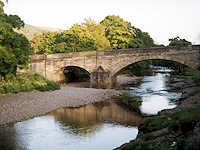

"A walk around Kettlewell". A book containing a fascinating history of buildings, and homes with memories from the people past and present of Kettlewell. Sixty six pages including forty rare photographs. Sold in the village shops and YDNP centres £3.50. A small extract below.
For a free update of the Book click here
Starting at
Kettlewell Garage which was first built in the 1920s and since 1946 has been run by the same family. Opposite is The Cottage Tea Room and Bed and Breakfast which dates mainly from the 19th century. Adjoining is Dale House, this was built originally as a railway hotel as it was hoped that the line would be extended from Threshfield to Wensleydale.
Bear right at
The Smithy Gift Shop, it was last used as a smithy in the early 1960s. Follow the road, up on your right is
Over and Under, an outdoor shop which is a part of Low Hall. On the east wall you can still see the outline of the original cottage which was then extended in the late 18th century. The small building in the garden opposite is the prettiest restored pigsty you will ever see. Further along on the right is Alva Cottage with its impressive oak door, this cottage dates from the 17th century
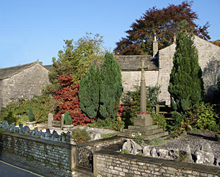

Walk on towards the War Memorial built to commemorate the fallen of the two World Wars, if you look carefully you will see that the village of Starbotton is miss spelt. Standing within the gardens are the old village stocks which originally stood along the Coniston Road. The two adjoining cottages on your left were built in the early 1900s; the second (Valley View) was the Police House until 1978.
Now you can see the Maypole dated 1898. The W.I to commemorate the Coronation of Elizabeth II in 1953, erected the present maypole. It stands where the village green once was and although the green has gone the area around it still bears that name.
Opposite stands
Littlebeck Bed and Breakfast. Part of the foundations of this house date from the 12th century and it would have been a long house. It was also one of the homes of the first schoolmaster in Kettlewell, Mr. Carradice (he taught from 1884 to 1923). On the right of the maypole is Spring Cottage, one of the loveliest late 17th century cottages in the village; Manor Cottage and Rose Cottage are also of the same period and just as attractive.


On toward
The Kings Head which dates from the 17th century, it is thought to have once been a mill and then a workhouse (the landlady says it still is!). Now turn left over the bridge and you are on the oldest route through the village - this ran from the "Stepping Stone" at Lovers Lane, past the church and out through Cam Lodge at the end of the road and up onto Cam Head.
The Village Store on your left was built in 1876 by Mr. Inman from the stone taken from the mill that once stood opposite.
Turn left again into Middle Lane, in front of you is a small cottage, which was once part of the village store. Next is Knipe View, once a Chapel with a stone inscribed "Jubilee 1863". The next building was Barclays Bank and you can still see the outline of the sign, two buildings along the back of the old joiners shop. Further down on the left is a Tea Shop. Going down with the beck on your left, the gaps in the walls were used by villagers to collect water. On to the Village Hall, this was built in 1926 with money donated by local subscriptions, the hall is well used throughout the year.
Greta House Bed and Breakfast dating from the 17th century was once the doctor’s surgery.
Opposite is
The Racehorses Hotel, originally a stable block for the Blue Bell Inn. The Race Horses is believed to derive its name from the trace horses, and these animals were hired as extra power to pull heavy wagons up Park Rash. The present hotel was built in 1740.
The Blue Bell Inn is the original coaching inn dating back to 1680, being on the ancient route through Kettlewell to Middleham and the North. Opposite on the side of the bridge the old mounting blocks can still be seen. Take the lane to the left of the Blue Bell, the cottages to the left were converted from the old stable blocks to the Inn. Further on is Cam Laithe, a converted barn, which has been restored by its present owners. Walking on up you come to Jasmine Cottage on the right. It was formerly a weaver’s cottage where the loom would have been upstairs. Opposite is a small lane leading onto the footpath to Starbotton.
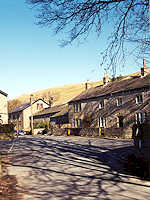

Now follow the road past West Gate Farm to the Vicarage on the left. This house has been extended in the early part of the 18th century. Take the road signposted Leyburn, the first house on the left is Damside House, this is where the books "Captain Kettle" (a Victorian James Bond) were written by Dr Cutcliffe Hyne in Victorian times. The house has two dates over its doors, 1681and 1815. Carry on along the road and on the right is the back of The Old Hall (we will talk about this later).
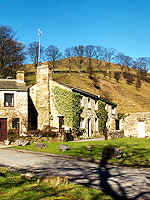

On the brow of the hill to the right is Chestnut Cottage, which dates from the 18th century and was originally three cottages. Standing on the top of the hill is The Old School House, which was built in 1867 but only used for two months and closed because of a religious feud. Continue along the road to Town Head, on your right is the old Methodist Chapel with its date of 1860, the door of the chapel is at the back because of flooding from the beck and the gravestones can still be seen in the gardens. The stained glass windows have been removed and placed in the Church.
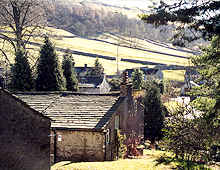

Go over the bridge and bear right and you will come to Ghyll Cottage. Near by in the beck are deep pools where the sheep were washed before clipping. On to Hawbank with its outside stone steps leading to the top of the cottage. Opposite in the beck you can still see the remains of the concrete pillars which supported the pipeline carrying water to the Electricity Generating House (the small building over the beck). Kettlewell was one of the first villages in the country to have its own electricity supply from 1913 to 1950s. A little way along on your left is Langcliffe Garth where you can find
Honeysuckle Cottage and
Lynburn Bed and Breakfast, this is a pleasant area of the village with its well-tended green. Continuing down, on your left is Langcliffe House where once stood the vicarage; beyond is Wears Cottages once the homes of lead miners. And onto
Fold Farm Holiday Cottages, there are four cottages all with floral names, these have been converted from a barn. Behind is Fold Farm historically one of the most important buildings in the Dale with its timber frame dating from the 1480s and is now a grade ll listed building.
On the opposite side of the beck you will know see The Old Hall with its delightful mullioned windows and lovely garden, it is thought to have been built in the 1600s. You are at the end of your walk now with New Leeds Cottages on the left. At one time they were known as a "Dandy Shop" in which four or five small weaving looms were fitted. It is said the noise of one loom in a cottage was considerable, but in the Dandy Shop it was said to be horrendous. And now we are back at The Kings Head.
The book
A Walk Around Kettlewell with 66 pages of history and 40 photographs is available from village shops.